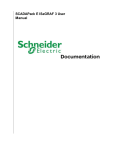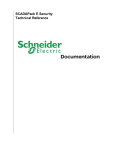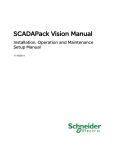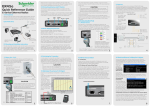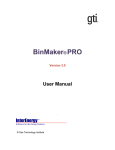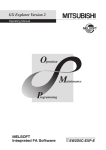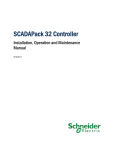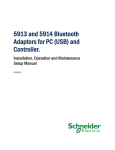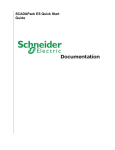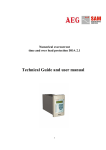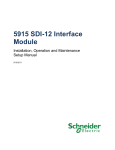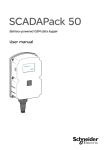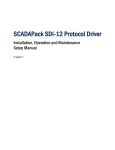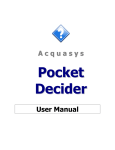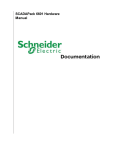Download SCADAPack E Conitel Slave Interface
Transcript
SCADAPack E Conitel Slave Interface 2 SCADAPack E Conitel Slave Interface Table of Contents Part I SCADAPack ER Conitel Slave Interface 3 1 Technical ................................................................................................................................... Support 3 2 Safety ................................................................................................................................... Information 4 3 Preface ................................................................................................................................... 6 4 Overview ................................................................................................................................... 8 5 Conitel................................................................................................................................... Protocol Configuration 9 5.1 Supported Function .......................................................................................................................................................... Codes 10 5.2 Physical Interface .......................................................................................................................................................... 14 5.3 Conitel Port Configuration .......................................................................................................................................................... 15 ......................................................................................................................................................... & Control/Execute Timeout 16 5.3.1 PTM and Squelch ......................................................................................................................................................... Timing & Protocol Select 17 5.3.2 Communication Address & Raise/Low er Control Settings 18 5.3.3 Function 9 ......................................................................................................................................................... 5.4 Conitel Slave Point .......................................................................................................................................................... Mapping 19 ......................................................................................................................................................... Function 20 5.4.1 Adding a Scan ......................................................................................................................................................... Function 22 5.4.2 Adding a Trip/Close ......................................................................................................................................................... er Function 25 5.4.3 Adding a Raise/Low Analog Setpoint Function 27 5.4.4 Adding an ......................................................................................................................................................... 5.5 Conitel Type Descriptions .......................................................................................................................................................... 28 ......................................................................................................................................................... 29 5.5.1 Notes/Restrictions 6 Baker................................................................................................................................... Protocol 30 6.1 Bit Ordering, Address .......................................................................................................................................................... Header, & Notes and Restrictions 31 6.2 Function Codes .......................................................................................................................................................... and Data Types 32 7 Appendix ................................................................................................................................... - System Points 33 8 Appendix ................................................................................................................................... - Conitel Protocol Summary 35 8.1 Conitel Fram es .......................................................................................................................................................... 36 8.2 Address Header .......................................................................................................................................................... 37 SCADAPack ER Conitel Slave Interface I 3 SCADAPack ER Conitel Slave Interface ©2013 Control Microsystems Inc. All rights reserved. Printed in Canada. Version: 8.05.4 The information provided in this documentation contains general descriptions and/or technical characteristics of the performance of the products contained herein. This documentation is not intended as a substitute for and is not to be used for determining suitability or reliability of these products for specific user applications. It is the duty of any such user or integrator to perform the appropriate and complete risk analysis, evaluation and testing of the products with respect to the relevant specific application or use thereof. Neither Schneider Electric nor any of its affiliates or subsidiaries shall be responsible or liable for misuse of the information contained herein. If you have any suggestions for improvements or amendments or have found errors in this publication, please notify us. No part of this document may be reproduced in any form or by any means, electronic or mechanical, including photocopying, without express written permission of Schneider Electric. All pertinent state, regional, and local safety regulations must be observed when installing and using this product. For reasons of safety and to help ensure compliance with documented system data, only the manufacturer should perform repairs to components. When devices are used for applications with technical safety requirements, the relevant instructions must be followed. Failure to use Schneider Electric software or approved software with our hardware products may result in injury, harm, or improper operating results. Failure to observe this information can result in injury or equipment damage. 1 Technical Support Support related to any part of this documentation can be directed to one of the following support centers. 4 SCADAPack E Conitel Slave Interface Technical Support: The Americas Available Monday to Friday 8:00am – 6:30pm Eastern Time Toll free within North America 1-888-226-6876 Direct Worldwide +1-613-591-1943 Email [email protected] Technical Support: Europe Available Monday to Friday 8:30am – 5:30pm Central European Time Direct Worldwide +31 (71) 597-1655 Email [email protected] Technical Support: Asia Available Monday to Friday 8:00am – 6:30pm Eastern Time (North America) Direct Worldwide +1-613-591-1943 Email [email protected] Technical Support: Australia 2 Inside Australia 1300 369 233 Email [email protected] Safety Information Read these instructions carefully, and look at the equipment to become familiar with the device before trying to install, operate, or maintain it. The following special messages may appear throughout this documentation or on the equipment to warn of potential hazards or to call attention to information that clarifies or simplifies a procedure. The addition of this symbol to a Danger or Warning safety label indicates that an electrical hazard exists, which will result in personal injury if the instructions are not followed. This is the safety alert symbol. It is used to alert you to potential personal injury hazards. Obey all safety messages that follow this symbol to avoid possible injury or death. SCADAPack ER Conitel Slave Interface 5 DANGER DANGER indicates an imminently hazardous situation which, if not avoided, will result in death or serious injury. WARNING WARNING indicates a potentially hazardous situation which, if not avoided, can result in death or serious injury. CAUTION CAUTION indicates a potentially hazardous situation which, if not avoided, can result in minor or moderate. CAUTION CAUTION used without the safety alert symbol, indicates a potentially hazardous situation which, if not avoided, can result in equipment damage.. PLEASE NOTE Electrical equipment should be installed, operated, serviced, and maintained only by qualified personnel. No responsibility is assumed by Schneider Electric for any consequences arising out of the use of this material. A qualified person is one who has skills and knowledge related to the construction and operation of electrical equipment and the installation, and has received safety training to recognize and avoid the hazards involved. BEFORE YOU BEGIN Do not use this product on machinery lacking effective point-of-operation guarding. Lack of effective point-of-operation guarding on a machine can result in serious injury to the operator of that machine. CAUTION EQUIPMENT OPERATION HAZARD Verify that all installation and set up procedures have been completed. Before operational tests are performed, remove all blocks or other temporary holding means used for shipment from all component devices. 6 SCADAPack E Conitel Slave Interface Remove tools, meters, and debris from equipment. Failure to follow these instructions can result in injury or equipment damage. Follow all start-up tests recommended in the equipment documentation. Store all equipment documentation for future references. Software testing must be done in both simulated and real environments. Verify that the completed system is free from all short circuits and grounds, except those grounds installed according to local regulations (according to the National Electrical Code in the U.S.A, for instance). If high-potential voltage testing is necessary, follow recommendations in equipment documentation to prevent accidental equipment damage. Before energizing equipment: Remove tools, meters, and debris from equipment. Close the equipment enclosure door. Remove ground from incoming power lines. Perform all start-up tests recommended by the manufacturer. OPERATION AND ADJUSTMENTS The following precautions are from the NEMA Standards Publication ICS 7.1-1995 (English version prevails): Regardless of the care exercised in the design and manufacture of equipment or in the selection and ratings of components, there are hazards that can be encountered if such equipment is improperly operated. It is sometimes possible to misadjust the equipment and thus produce unsatisfactory or unsafe operation. Always use the manufacturer’s instructions as a guide for functional adjustments. Personnel who have access to these adjustments should be familiar with the equipment manufacturer’s instructions and the machinery used with the electrical equipment. Only those operational adjustments actually required by the operator should be accessible to the operator. Access to other controls should be restricted to prevent unauthorized changes in operating characteristics. 3 Preface Purpose The purpose of this document is to describe the SCADAPack ER RTU driver for the Conitel protocol, and using it for communicating with Conitel or Baker capable master station equipment. SCADAPack ER Conitel Slave Interface 7 References Schneider Electric SCADAPack ER-P620 Processor Hardware Manual Glossary The terms in this glossary are described in the context of Conitel operation on SCADAPack E RTUs. ACRONYM DESCRIPTION Byte Unsigned 8-bit value CD Carrier Detect from Modem – connects to serial port CTS CTS Clear to send –indicates carrier detected on serial port COS Change of state FC Function Code in header of a Conitel message LSB Least Significant Bit MSB Most Significant Bit PTM Pre-Transmission Mark PTT Push-To-Talk output (for keying transmission) R/L Raise / Lower RTC Real time clock RTS Ready to send – keys an external Conitel modem Word Unsigned 16-bit value 8 4 SCADAPack E Conitel Slave Interface Overview Conitel is a half duplex (master/slave) bit-stream protocol developed by Leeds & Northrup. It is in wide use internationally, providing communication with RTU devices. This document describes how the SCADAPack E firmware on the SCADAPack ER - P620 Processor Module communicates as a slave unit on a Conitel network. The SCADAPack ER - P620 processor interfaces to Conitel communication circuits through V.28 (RS232 level) serial interfaces (see the SCADAPack ER - P620 hardware manual for more information). Up to 4 Conitel communication interfaces are supported simultaneously on the SCADAPack ER - P620 processor. Operation with ITU-T V.23 or Bell-202 (FSK) interfaces for leased circuits requires the use of external modems. Baker protocol is a variant of Conitel, compatible at the physical and framing level, and utilizing some of the same concepts as the Conitel protocol. The SCADAPack E firmware supports both Conitel and Baker protocol. Although the SCADAPack E configuration selects either Conitel or Baker operation, throughout this document the use of the both Conitel and Baker protocol is generally referred to simply as “Conitel”. See Section Baker Protocol 30 for information specific to Baker protocol. This document outlines the following: Description of the Conitel and Baker protocols Physical interfaces to the Conitel network Mapping of Conitel data to SCADAPack E RTU points Processing and responding to received messages in the SCADAPack E firmware The Conitel Slave protocol is supported on multiple ports on the SCADAPack ER - P620 processor module. Any combination of Ports 5~8 can be used. Where multiple Conitel ports are used simultaneously, they access a single RTU Conitel configuration and mapping database. SCADAPack ER Conitel Slave Interface 5 Conitel Protocol Configuration Supported Function Codes Physical Interface 10 14 Conitel Port Configuration 15 Conitel Slave Point Mapping Conitel Type Descriptions 28 19 9 10 5.1 SCADAPack E Conitel Slave Interface Supported Function Codes The Function Codes (FC) that are supported by the SCADAPack E Conitel driver are outlined in the following table: Table 5.1: Conitel Function Codes Fn Code (Hex) 0 FUNCTION Scan NOTES Configurations for Responses to Scan are detailed in Section Adding a Scan Function 20 1 Execute 2 Trip Only 1 bit can be controlled in each Trip message. See Section Adding a Trip/Close Function 22 3 Setpoint (A) See Section Adding an Analog Setpoint Function 27 4 Close Only 1 bit can be controlled in each Close message. See Section Adding a Trip/Close Function 22 5 Setpoint (B) See Section Adding an Analog Setpoint Function 27 6 -------- 7 -------- 8 -------- 9 Master Station Request See Table 5.2: Function 9 Group Codes for Group Codes A New SOE Events Configurations for SOE points are detailed in Section Adding a Scan Function 20 B Repeat SOE Events C -------- D Unit Raise/Lower E Freeze and Scan Accumulators See Section Adding a Scan Function mapping Accumulators to scan groups 20 for F Freeze/Scan Accumulators and Reset See Section Adding a Scan Function mapping Accumulators to scan groups 20 for 11 When a Raise/Lower is currently being executed, a concurrently received Raise/Lower command replaces the in-progress command. Configuration is described in Section Adding a Raise/Lower Function 25 SCADAPack ER Conitel Slave Interface 11 Table 5.2: Function 9 Group Codes Group Function Code Supported Notes 0 Unused 1 Test RAM Returns good 2 Test PROM checksum Returns good 3 Test EPROM checksum Returns good as Conitel driver only boots if check passes 4 Test I/O Controller Data Bus Returns the state of the RTU's I/O Processing CPU 5 Download Data (Download Time) 6 Unused 7 Unused 8 Remote Status Request See Table 5.3 Remote Status Information 12 for supported status bits 9 Read Input Directly Not implemented A Read Comms parameters and time correction factor. B Repeat last message C Unused D Loop-back mode E ‘Warm’ Restart RTU Sends an RTU hardware Restart F ‘Cold’ Restart RTU Sends an RTU hardware Restart Valid if previous message has been sent 12 SCADAPack E Conitel Slave Interface Table 5.3: Remote Status Information Fn 9 Group 8 Remote Status Frame Bits Bit Description SCADAPack ER P620 Notes 1-4 (MSBs) Error Code See Table 5.4: Remote Status Frame Error Code 12 for error codes 5 Controls Isolated Not supported 6 RTU Reset has occurred Returns True (1) on the first status request after a reset then False (0) thereafter 7 Field Interrogator Supply is low. Not implemented (0) 8 Power low Internal Battery low or Input Supply low 9 Accumulator Overflow Change. 10 Accumulator Overflow Status. These 2 bits are represented by ‘one-bit MCD’ data type 11 SOE events overflow Set if Conitel Event buffer has filled 12 (LSB) SOE events present Set when a Conitel event is generated. Cleared when all Conitel events are read Table 5.4: Remote Status Frame Error Code Fn 9 Group 8 Remote Status Frame 4-bit Error Code value Error code (Hex) Description SCADAPack ER - P620 Notes 0 Normal Operation 1 Power fail 2 Spare 3 Control Error Set if control cannot be executed. E.g. if sent to a point under ISaGRAF control, or point not configured correctly 4 Comms Error Not implemented 5 Configuration/Scan Error Set if there is an error in the Conitel table configuration. 6 Timer Overrun Not implemented 7 Address Error Not implemented 8 Bus Error Not implemented From power low bits (see table above) SCADAPack ER Conitel Slave Interface 9 Software Error Set if a software watchdog was previously detected (and not cleared) A Spare B RAM Error Not implemented C I/O Controller Hardware error Set if an error is returned from RTU’s I/O processing CPU D Configuration PROM Checksum test Not implemented failure E Program PROM Checksum test failure F Reset Operation (Fn 9, Code E or F) Not implemented in progress. Not implemented 13 14 5.2 SCADAPack E Conitel Slave Interface Physical Interface The physical interface provided by the SCADAPack ER - P620 processor for Conitel ports is 4 x RJ-12 ports, using V.28 (RS232 levels). These can be used on a direct V.28 Conitel interface, or connected to a V.23 or Bell 202 modem. Conitel is usually transmitted over 4-wires using Bell 202 or ITU-T V.23 at 1200 baud. The RTS line from the RJ-12 port acts as RTS (also known as PTT) for the modem. The CTS line on the RJ-12 port is used as a CD line from the modem. See the SCADAPack ER Hardware User Manual for cable wiring information for RJ-12 ports. Two configuration parameters are provided for each Conitel port: PTM Time and Squelch Time. For received Conitel data to be validated, the carrier needs to be received for a period longer than the configured Squelch Time, and the data needs to pass the Conitel framing checks. When transmitting messages out a Conitel port, the driver will first key the RTS line and then assert the PTM for the configured length of time. See Section Communication Timing & Control/Execute Timeout (Communication Timing) 17 for more information. SCADAPack ER Conitel Slave Interface 5.3 15 Conitel Port Configuration To configure a SCADAPack ER - P620 processor for Conitel operation, select the SCADAPack ER then P620 model processor module when you first start SCADAPack E Configurator. You can also select this later by using “View->Change RTU Model…” and select SCADAPack ER, then SCADAPack ER - P620. On the “Ports 5-8” page, configure at least one port for Conitel Slave. Set the required Conitel configurations, as in the example below. Download the configurations to the RTU when you have completed the RTU configuration. Connect the SCADAPack ER - P620 processor to a suitable V.28 interface, V.23 or Bell 202 modem using the hardware lines as described in Section Physical Interface 14 . Figure 5.1: Conitel Port Configuration PTM and Squelch & Control/Execute Timeout Communication Timing & Protocol Select 16 17 Function 9 Address & Raise/Lower Control Settings 18 16 5.3.1 SCADAPack E Conitel Slave Interface PTM and Squelch & Control/Execute Timeout PTM and Squelch The PTM and Squelch values required will depend on the physical network that you are transmitting across. The PTM is transmitted at the start of a message and its value is dependant on the transmission delays across the network and the delays inherent in stabilizing transmitting and receiving modems. The Squelch time is used to determine if a valid message is being received. When Carrier Detect is received by the RTU, the Conitel driver will verify that the inbound PTM is longer than the configured Squelch. It does this by starting the squelch timer following reception of the CTS (CD) signal, then starts looking for a Conitel frame Start Bit following the squelch time period. The Squelch time at the receiver is therefore dependent on not only the transmission times on the network, but also the PTM at the other (transmitting) end. See Figure 5.2 Conitel Communication Timing 17 . Control/Execute Timeout This timer is started when a valid Trip/Close or Setpoint A/B function code is received. If the corresponding Execute command is not received within this timeout, then the control is discarded. SCADAPack ER Conitel Slave Interface 5.3.2 17 Communication Timing & Protocol Select Communication Timing The following diagrams show the relationship between the various timing parameters Figure 5.2: Conitel Communication Timing For information on Post Transmission Mark (Post TM) parameters, see Section Appendix - System Points 33 (Post Transmission Mark) 33 . Protocol Select Select whether the system is running Conitel or Baker protocol. Also see Section Baker Protocol 30 . 18 5.3.3 SCADAPack E Conitel Slave Interface Function 9 Address & Raise/Lower Control Settings Function 9 Address This address needs to be configured if you require the SCADAPack E firmware Conitel driver to respond to Conitel Function 9 requests. If configured, then this RTU will respond to Function 9 requests directed at this address. As the SCADAPack E firmware Conitel driver can respond to multiple Conitel Station and Group addresses (see below), this field is available to allow operation of Function 9 in conjunction with multidropping of RTU’s. Raise/Lower Control Settings These settings relate to Raise/Lower (R/L) controls. A Raise/Lower control for a single point in Conitel consists of 4-bits of information. One bit determines whether it is a raise or lower control, and the other three bits determine the number of periods (N) to pulse the point for. The total period of time that the point is pulsed, is calculated by the following formula: Pulse Period = R/L Offset(ms) + (R/L Timebase x N)(ms). For example, if R/L Offset = 250ms and R/L Timebase = 150ms, then for a Raise control received with N=3, the Raise output will be pulsed for 250 + 150*3 = 700ms. Generally, R/L controls are used so that a Raise command pulses one physical output point, and a Lower command pulses a different physical output point. However, R/L controls may be passed through a data concentrator to remote devices. See Section Adding a Raise/Lower Function 25 for further information on point mapping for Raise / Lower controls. SCADAPack ER Conitel Slave Interface 5.4 19 Conitel Slave Point Mapping To map RTU points through to the Conitel Slave interface, a “Conitel Slave” page is provided in the RTU configuration software. To access this page, check that the hardware type is set as SCADAPack ER P620 in the “Change RTU Model” wizard and that Conitel Slave is also selected in the “RTU Features” dialog. The Conitel Slave page consists of 2 graphical tables: The first table is used for adding station/groups that the RTU is to respond to for various function codes. Once a station/group/function entry has been added to this table, then points can be mapped to it using the Point Mapping table. This second table maps RTU points to positions in the selected Conitel response frame. Figure 5.3: Conitel Point Configuration The following functions are supported for Conitel station/group entries: Scan Fn Trip/Close Fn Raise/Lower Fn Setpoint Fn The function menu includes “Reset Fn (Baker)” but this is specifically for Baker protocol only (see Section Function Codes and Data Types [Reset] 32 ) and is not supported by Conitel. Adding a Scan Function 20 Adding a Trip/Close Function 22 Adding a Raise/Lower Function 25 Adding an Analog Setpoint Function 27 20 5.4.1 SCADAPack E Conitel Slave Interface Adding a Scan Function Press the “Add Group” button and select Scan Fn as the Response Type. Give the response group appropriate Conitel Station and Group numbers. A new row will be added to the table on the left. Select this row and then the available 31 frames will be shown in the Point Mapping table on the right. RTU points can now be added to the Scan response Point Mapping table by first selecting a Type from the available drop-down list and then attaching an appropriate RTU database point for this type. For a list and description of the various Conitel Point types see Table 5.7 Conitel Point Type 28 . Figure 5.4: Scan Function Configuration The following restrictions apply when selecting the Conitel Type: A Conitel scan response can maximally return 31 frames. Each frame contains 12 bits Frames containing user specified data are labeled 1B, 2A, 2B, …. 16A, 16B SOE ID’s can only be set when the Conitel Type is binary (i.e. 1-bit binary or 2-bit MCD). Each RTU has a limit of 120 unique SOE ID’s 2-Bit MCD types consume 2-bits in the frame, and can only be located at odd bit numbers in the frame Analog points, Status frame, and 12-bit Accumulators consume a whole frame (12-bits). The remainder of the bits in the frame will not be shown if these types are selected. They can only be selected on the first bit in a frame The status register does not require a database point number RTU database Analog Point scaling should be used to scale physical analog inputs into the 12-bit SCADAPack ER Conitel Slave Interface 21 range -2048 to 2047. 24-bit Accumulators consume 2 frames. This type also can only be located as the first bit in a frame, and it cannot be located in the last frame (frame 16B). RTU Database points are selected by their DNP3 address (even if they are not being used for DNP3 communications) If the selected point currently does not exist in the RTU point database, then the user will be prompted to add the point, if desired. 22 5.4.2 SCADAPack E Conitel Slave Interface Adding a Trip/Close Function Press the “Add Group” button and select Trip/Close Fn as the Response Type. Give the response group appropriate Conitel Station and Group numbers. Select this row in the response group table, and then the available frame will be shown in the Point Mapping table on the right hand side. Trip/Close controls can only utilize 12 control points (i.e. a single frame). To pulse physical output points using the Trip/Close function code, two points are required in the SCADAPack E RTU database. A main point and a partner point needs to be configured. In this case, the pulse duration for the outputs is determined by the output point’s configured “Output Pulse Time” attribute, which needs to be non-zero to operate correctly. Figure 5.5: Trip/Close Function Configuration Conitel Trip/Close commands may operate as Pulse, Latch or Unlatch commands to the SCADAPack E RTU or RTUs remote from the RTU using Conitel, depending upon the configuration of the mapped SCADAPack E RTU points. See Table 5.5 23 . Where SCADAPack E RTU is used as a Conitel Slave and where points on its local output modules are used for Trip / Close commands, the 2 Trip points need to be configured as partner points in the RTU. Only one of the two points needs to be mapped to the Trip/Close control in the RTU configuration. For more information on partner points see the SCADAPack E Configuration Technical Reference. Where an SCADAPack E RTU is used as a Conitel Slave and a data concentrator to other devices (e.g. DNP3 RTUs), a partner point MAY be defined but is NOT required to be defined for Trip / Close controls. This allows controls to be sent to remote RTU devices using either “single index” or “dual index” addressing. SCADAPack ER Conitel Slave Interface 23 The following table describes the result of receiving Conitel Trip / Close controls. Table 5.5: SCADAPack E RTU Trip / Close Command Results Operation as / Output point location End node RTU / Physical output on RTU module Conitel Output point’s Control Pulse Time Receiv field value: ed TRIP Non-zero Output point’s Partner Point Result field value: Valid index of partner point (not 65535) Timed PULSE operation on the physical output point (lowest point number of the partner point pair) MANDATORY CLOSE Non-zero Valid index of partner point (not 65535) Timed PULSE operation on the physical output point (highest point number of the partner point pair) MANDATORY End node RTU / Physical output on RTU module TRIP CLOSE Data concentrator TRIP / Output on remote RTU CLOSE Data concentrator TRIP / Output on remote RTU CLOSE Data concentrator TRIP / Output on remote RTU CLOSE 0 IGNORED UNLATCH operation on the local output point mapped in the Conitel Slave table IGNORED LATCH operation on the local output point mapped in the Conitel Slave table 0 Non-zero 65535 (disabled) Timed DNP3 TRIP command sent to (single index) remote RTU point Non-zero 65535 (disabled) Timed DNP3 CLOSE command sent to (single index) remote RTU point Non-zero Valid index of partner point (not 65535) Timed TRIP command sent to (dual index) remote RTU output point equivalent to lowest point number of the partner point pair Non-zero Valid index of partner point (not 65535) Timed CLOSE command sent to (dual index) remote RTU output equivalent to the highest point number of the partner point pair 0 IGNORED UNLATCH command sent to remote RTU point 0 IGNORED LATCH command sent to 24 SCADAPack E Conitel Slave Interface Operation as / Output point location Conitel Output point’s Control Pulse Time Receiv field value: ed Output point’s Partner Point Result field value: remote RTU point SCADAPack ER Conitel Slave Interface 5.4.3 25 Adding a Raise/Lower Function Press the “Add Group” button and select Raise/Lower Fn as the Response Type. Give the response group appropriate Conitel Station and Group numbers. Select this row in the response group table, then the available frame will be shown in the Point Mapping table on the right hand side. Raise/Lower controls from the master can only utilize 3 control points, as each control in the frame uses 4-bits. For the pulse to work correctly in Raise/Lower controls, the appropriate timing parameters need also be setup (see Section Function 9 Address & Raise/Lower Control Settings 18 [Raise/Lower Control Settings] 18 ). Figure 5.6: Raise/Lower Function Configuration Where an RTU is used as a Conitel Slave and where points on its physical output modules are used for R/L commands, the 2 R/L points needs to be configured as partner points in the RTU. Only one of the two points needs to be mapped to the R/L control in the RTU configuration. For more information on partner points see the SCADAPack E Configuration Technical Reference. Where an SCADAPack E RTU is used as both a Conitel Slave and a data concentrator to other devices (e.g. DNP3 RTUs), a partner point MAY be defined but is NOT required to be defined for R/L controls. This allows controls to be sent to remote RTU devices using either “single index” or “dual index” addressing. The following table describes the result of receiving Conitel Raise / Lower controls. Table 5.6: SCADAPack E RTU Raise / Lower Command Results Operation as / Output point location End node RTU / Physical output Physical RTU module Conitel Output point’s Control Partner Point Received field value: RAISE Valid index of partner point (not 65535) Result Timed PULSE operation on the physical output point (lowest point number of the partner point pair) MANDATORY LOWER Valid index of Timed PULSE operation on the 26 SCADAPack E Conitel Slave Interface partner point (not 65535) physical output point (highest point number of the partner point pair) MANDATORY Data concentrator RAISE / Output on remote RTU LOWER Data concentrator RAISE / Output on remote RTU LOWER 65535 (disabled) DNP3 CLOSE command with calculated pulse time sent to (single index) output point on remote RTU 65535 (disabled) DNP3 TRIP command with calculated pulse time sent to (single index) output point on remote RTU Valid index of partner point (not 65535) DNP3 CLOSE command with calculated pulse time sent to (dual index) remote RTU output point equivalent to the highest point number of the partner point pair Valid index of partner point (not 65535) DNP3 TRIP command with calculated pulse time sent to (dual index) remote RTU output equivalent to the (lowest point number of the partner point pair) SCADAPack ER Conitel Slave Interface 5.4.4 27 Adding an Analog Setpoint Function Press the “Add Group” button and select Setpoint Fn as the Response Type. Give the response group appropriate Station and Group numbers. Select this row in the response group table, and then the available frames will be shown in the Point Mapping table on the right hand side. There are 2 separate Analog setpoints available for each Station/Group combination. These are referred to as Setpoint A and Setpoint B controls and they utilize different function codes in the Conitel protocol. Each setpoint may be mapped to an SCADAPack E RTU database analog point. Figure 5.7: Analog Setpoint Function Configuration 28 5.5 SCADAPack E Conitel Slave Interface Conitel Type Descriptions The table below outlines the various Conitel data Types available when mapping SCADAPack E RTU points to Conitel frames. Table 5.7: Conitel Point Types Conitel Type Description Number of bits Notes NIL 1-Bit Binary Single binary value 1 2-Bit MCDA Binary OFF to ON transition detection. Status of input is inverted 2 2-Bit MCDB Binary ON to OFF transition detection 2 2=Bit MCDC Binary More than 1 transition detected 2 12-Bit ANALOG Analog point (range –2048~2047) 12 12-Bit Accumulator Accumulator (range 0~4095) 12 24-Bit Accumulator Accumulator (range 0~16777216) 24 TRIP/CLOSE Output Digital Output bit – single binary ANALOG Output Analog Output point (range 0~4095) RAISE/LOWER Raise/Lower pulsed output Output STATUS Frame RTU status frame (known as Conitel Remote Status) - see Table 5.3 Remote Status Information 12 Must be allocated to an odd bit number in the configuration 1 12 4 12 Status frame can only be mapped once in an SCADAPack E RTU MCD = Momentary Change Detect. MCDA = MCD type A; MCDB = MCD type B; MCDC = MCD type C. Notes/Restrictions 29 SCADAPack ER Conitel Slave Interface 5.5.1 29 Notes/Restrictions The RTU’s Conitel driver performs configuration validation on start-up. RTU Error Code 3005 is generated if a Conitel configuration is found to be invalid. The following items describe the operation of the SCADAPack E RTU Conitel driver: Station address 0 will be processed by the RTU as this is a broadcast address. No response will be generated. If the Conitel Driver encounters an error while in the process of decoding or responding to a valid request from the master station, then it will cancel the current transmission (i.e. drop PTT). The SOE buffer in the Conitel driver will store up to 500 events. There are 2 of these buffers, one for the current (unreported) events, and one for the previously reported events (used with Function Code B). A ‘frozen accumulator’ buffer stores the last frozen accumulator values. When FC 9 is used then the Group address becomes a sub-code. This means that the only way to identify a device address for a FC 9 request is by using the Station address bits. However, multiple physical devices may share the same Station address so they would respond to a FC 9 request at a given Station address. (In many cases devices are segregated by Station address AND Group address. In the case of FC 9 the group address is used for a different purpose, potentially causing a problem). A separate FC 9 address configuration is provided by the SCADAPack E RTU to overcome this. Where function code 9 is used in a system, the configuration of this field needs to be unique between RTUs multi-dropped on the same Conitel communications link. Accumulators that internally can have values larger than their type can represent (i.e. either larger than 12 or 24 bits) will wrap when the limit for that type is reached. I.e. the least significant 12 or 24 bits will be presented. If a Raise or Lower operation for a given point is already executing and concurrently a new Raise or Lower command is received for the same point, the SCADAPack E RTU will replace the currently executing operation with the newly received operation, as per the Conitel specification. Raise/Lower command: A Raise command translates to a CLOSE control when mapped to other protocols in an SCADAPack E RTU (DNP3, IEC60870-5 suite, etc). A Lower command translates to a TRIP control. 30 6 SCADAPack E Conitel Slave Interface Baker Protocol The Baker Slave Protocol is very similar to the Conitel Slave Protocol. The RTU’s Conitel Driver can be configured to interpret frames in Baker compatible format. This section outlines the differences in the two protocols, and the aspects of the configuration that change when Baker Protocol is selected. Bit Ordering, Address Header, & Notes and Restrictions Function Codes and Data Types 32 31 SCADAPack ER Conitel Slave Interface 6.1 31 Bit Ordering, Address Header, & Notes and Restrictions Bit Ordering In Baker Protocol, the bits in each frame are numbered 12(MSB) – 1(LSB), with bit 12 is the first bit transmitted. This is the opposite of the Conitel Protocol which numbers 1(MSB) – 12(LSB) and transmits bit 1 first. The Conitel Point Mapping table has bit numbers going from 1(MSB) to 12(LSB). The user needs to be aware of this and convert numbering in the Point Mapping table appropriately when using Baker protocol. Address Header The Address Header frame has 3-bits for the function code, 6-bits for the Station Address, and 3-bits for the Set Address. The most significant bit of the station address is set aside for the execute function code (see Section Select Execute 32 ). The functions codes specified for the first 3-bits match the same function codes as described by the Conitel Protocol above. The 5-bit Station Address specifies one of up to 32 RTU’s on a communication channel. The Set Address for the Baker Protocol selects which particular set of inputs or outputs are to be accessed. Typically, Baker protocol requires mapping as follows: 000 – AI Scan (or Control Activate) 001 – 1st set of 12 control points available for Trip/Close 010 – 2nd set… 011 – 3rd set… 100 – 4th set… 101 – 5th set… 110 – MCD and SDI Scan 111 – SDI Scan Notes and Restrictions When selected for operation with the Baker protocol, the following Conitel configurations are not used (as they are not supported by Baker protocol): Fn9 Address R/L Timebase R/L Offset The RTU’s Conitel / Baker driver performs configuration validation on start-up. RTU Error Code 3006 is generated if a data type is configured that is not supported by Baker protocol. 32 6.2 SCADAPack E Conitel Slave Interface Function Codes and Data Types The Baker protocol supports the following Function Codes: 0 – Scan 1 – Execute 2 – Trip 4 – Close 8 – Reset The user should not configured other Function Codes (i.e. Raise/Lower and Setpoint functions are not supported in Baker protocol mode) Scan The data types supported for the Scan function with Baker protocol are: BIN1 – Single bit binaries MCC – Multiple change detect ANALOG – Signed 12-bit analog STATUS – 12-bit Status register supported The user should not configure other data types when using Baker protocol. Select Execute The most significant bit of the BAKER address bits is set aside for the EXECUTE command. This is issued following a TRIP/CLOSE select. This effectively means the function code is a 4-bit number and an execute command will set the first bit (along with the select function code). For example, when a Select/Execute control is performed on the RTU, the sequence of function codes sent to the RTU would be: For a TRIP, fn code 0x2, followed by an EXECUTE-TRIP fn code 0x3. For a CLOSE, fn code 0x4, followed by an EXECUTE-CLOSE fn code 0x5. The SCADAPack E firmware manages the Baker protocol differences for Execute. The user does not required to make any additional considerations compared with its use with Conitel protocol. Reset The RESET function code will send a pulse command to the mapped RTU database point. For this control to work successfully, the point configuration for the output point needs to include a pulse time. The Reset command will operate in the RTU without receiving an Execute command. SCADAPack ER Conitel Slave Interface 7 33 Appendix - System Points Configuration System Points The following table defines the SCADAPack E Conitel driver configuration System Points. These points are 16-bit analogs. Table 7.1: SCADAPack E Conitel Slave RTU System Points DNP Point Number Default Value Name 57300 200 Port 5 PTM Pre-transmission mark (ms) 57301 200 Port 6 PTM Pre-transmission mark (ms) 57302 200 Port 7 PTM Pre-transmission mark (ms) 57303 200 Port 8 PTM Pre-transmission mark (ms) 57304 10 Port 5 Squelch Squelch time (ms) 57305 10 Port 6 Squelch Squelch time (ms) 57306 10 Port 7 Squelch Squelch time (ms) 57307 10 Port 8 Squelch Squelch time (ms) 57308 10 Ctrl Execute Timeout Timeout between a control and execute (S) 57309 0 Fn 9 Address Address to respond to Fn 9 requests 57310 100 R/L Timebase Raise Lower Timebase (see Section Function 9 Address & Raise/Lower Control Settings [Raise/ Lower Control Settings] 18 ) 57311 100 R/L Offset Raise Lower Offset (see Section Function 9 Address & Raise/Lower Control Settings [Raise/ Lower Control Settings] 18 ) 57312 0 Protocol Select between slave protocols: 0 – Conitel Slave 1 – Baker Slave 57313 1 Port 5 Post TM Post-transmission mark (ms) 57314 1 Port 6 Post TM Post-transmission mark (ms) 57315 1 Port 7 Post TM Post-transmission mark (ms) 57316 1 Port 8 Post TM Post-transmission mark (ms) Post Transmission Mark Description 34 SCADAPack E Conitel Slave Interface The Post Transmission Mark parameters shown in Table 7.1 SCADAPack E Conitel Driver System Points 33 are not brought out to the RTU Configuration software directly. In many circumstances the default value for a port’s Post TM is sufficient (1 ms). However, if data corruption is occurring at the end of messages, this time can be extended by setting the RTU System point for the appropriate port. Also see communication-timing diagrams in Section Communication Timing & Protocol Select (Communication Timing) 17 . SCADAPack ER Conitel Slave Interface 8 Appendix - Conitel Protocol Summary Conitel Frames 36 Address Header 37 35 36 8.1 SCADAPack E Conitel Slave Interface Conitel Frames The Conitel protocol is a bit-wise protocol where 32-bits comprise a Block. In a single Conitel message there is a maximum of 16 Blocks (therefore maximum Conitel message size is 512 bits). The first Conitel 32-bit Block has the following format. The PTM and Start-bit are not included in subsequent Blocks: Figure 8.1: Conitel Header Block The PTM and Start-bit pre-pend the first Block in a message. The Start-bit is 0. The first A Section of a message will be an address header frame (see Section Address Header 37 ), then subsequent Sections will be data (Sections are also referred to as Frames). The A-bit will be 0 if the A-section contains the address header or 1 otherwise for data sections. The B Section contains data. The B-bit is zero. The BCH is a cyclic error check algorithm, but can be conveniently calculated by XORing the values from the following table if the corresponding bit in the message is set: Table 8.1: BCH Codes Bit Code Bit Code Bit Code Bit Code A1 12 A8 0F B1 13 B8 11 A2 09 A9 15 B2 1B B9 1A A3 16 A10 18 B3 1F B10 0D A4 0B A11 0C B4 1D B11 14 A5 17 A12 06 B5 1C B12 0A A6 19 B6 0E A7 1E B7 07 B-bit 05 A-bit 03 The EOM bit is 1 for the final Block in the message, or 0 otherwise. SCADAPack ER Conitel Slave Interface 8.2 37 Address Header The address is always the first frame in a message. The format of the 12-bit address header is as follows: Figure 8.2: Conitel Address Header The Function Codes are described below. The Conitel protocol allows for 15 Station Addresses (1-15) with 0 reserved for a broadcast address. Each of these 15 individual station addresses can utilize 16 separate Groups. In theory, this means that the 240 unique 8-bit Station/Group numbers can be used for logical RTU’s, or, conversely, a single RTU may be configured to respond to up to 240 combinations. 38 SCADAPack E Conitel Slave Interface






































